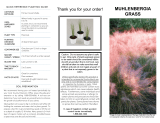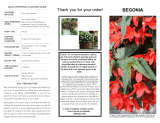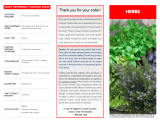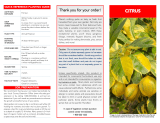
SOIL PREPARATION
Full sun to part shade.
LIGHT/SUN
EXPOSURE
USDA HARDINESS
ZONES
PLANTING
DISTANCE
IN-GROUND
Green Giant: 15 feet apart.
Emerald Green: 2 - 3 feet apart.
MATURE
HEIGHT / SPREAD
Green Giant: 30 to 60 feet tall
with a 12 to 18 foot spread.
Emerald Green:10 to 12 feet
tall with a 3 to 4 foot spread.
10 years.
Evergreen.
Drought tolerant once established.
Makes an excellent privacy screen
or windbreak.
TIME TO REACH
MATURITY
FACTS OF NOTE
PLANT TYPE
Perennial.
CONTAINER SIZE
One plant per 24-inch or larger
container.
We recommend having your soil tested periodically by
your local County Extension Office (www.nifa.usda.gov/
extension or by calling 1-800-333-4636). A soil test can
determine if your soil needs any amendments to enhance
the growth and performance of your plants.
Ideal garden soil is easy to dig in and drains well while still
holding the nutrients and water vital to plant growth. To
prepare a bed for in-ground planting, spade or till the soil
to a depth of roughly 12-18 inches. Next, spread a 2-4 inch
layer of organic matter such as compost, shredded leaves
or peat moss over the soil and mix well.
QUICK REFERENCE PLANTING GUIDE
Thank you for your order!
Growing as a slender tree with a pyramidal habit
and rich evergreen foliage, Arborvitae is ideal as
a privacy screen, windbreak, or decorative accent
in the landscape. Its large habit makes it perfect
for filling gaps in the landscape, and its foliage
remains attractive all year long.
Caution: Do not assume any plant is safe to eat.
Only parts of plants expressly grown to be eaten
should be considered edible. As with any product
that is not food, care should be taken to make
sure that small children and pets do not ingest
any part of the plant that is not expressly grown to
be eaten.
Unless specifically stated, this product is intend-
ed for ornamental horticultural use only and is
not intended for consumption or ingestion by
humans or pets. Most plants are harmless, but
some contain toxic substances which can cause
adverse health effects. Furthermore, some indi-
viduals and some animals are sensitive or allergic
to certain plants and precautions should be taken
to limit or avoid physical contact with particular
plants. Some plants have thorns or spines that
can be painful if handled.
In case of ingestion contact a poison
control center immediately.
1-800-222-1222
Green Giant: 5 to 8.
Emerald Green: 2 to 7.
ARBORVITAE
*Image on cover is representative of the type of plant(s) in this offer
and not necessarily indicative of actual size or color for the included
variety.

PLANTING INSTRUCTIONS (Continued)
PLANTING INSTRUCTIONS
FEEDING
Feed your plants once every 2-3 weeks during the
growing season with a water-soluble fertilizer for
acid loving plants. Discontinue feeding after
September 1st so your plants can harden off for
winter dormancy. Resume fertilizing when new
growth appears in spring.
WATERING
WINTERIZING
Watering thoroughly in late fall will greatly enhance
your plant's cold tolerance once the ground has
frozen.
Arborvitae is incredibly hardy, but will benefit from
mulching in very cold areas. The time to winterize it
is in late fall. When winterizing perennials, keep in
mind that the root system is the most vulnerable to
cold damage. Mulch heavily by mounding a 6-8 inch
layer of shredded bark, compost, leaves, straw or
other organic material around the base of each
plant.
In areas that receive heavy snowfall, burlap or netting
may be wrapped around each plant to prevent the
branches from breaking under the weight of snow
and ice.
In very cold areas, containerized plants can be
brought into an unheated, protected area such as a
garage or cellar before temperatures drop below
freezing. Check soil moisture every 2-3 weeks and
water as needed during winter.
In spring, remove mulch and any burlap or netting
from in-ground plantings. Containerized plants
should be moved back out into the garden sunlight
where they will begin to repeat their yearly garden
performance.
CONTINUING CARE (Continued)
4. Dig a hole twice as deep and twice as wide as the plant's
root ball. Partially backfill the hole with soil and place the
plant into the hole. The top of the root ball should be level
with the ground surrounding the hole. Refill the hole with
soil, firming the soil around the plant with your fingers.
Check to be sure the plant is not planted too deeply. If it is,
raise the plant carefully and re-firm the soil.
5. Water thoroughly.
CONTINUING CARE
Adequate and consistent watering is essential during
your plant's first year in the garden. Infrequent, long
soakings of water that thoroughly saturate the soil
are more effective than frequent, light applications of
water.
Due to variable geographical and environmental
conditions, a specific watering schedule is difficult to
define. However, as a rule of thumb, you should not
allow the soil or the original root ball to completely
dry out. During the first summer, you may need to
water as often as every few days in periods of
drought and extreme summer heat. To determine if
your plant needs water, dig a few inches into the soil
next to the plant. If the soil is dry 2-3 inches below the
surface, it is time to water.
Overwatering can be as damaging as under watering.
Be sure that the area surrounding your plant has
adequate drainage to move water away from the
plant. If you choose to plant in a container, always
select one with drainage holes to prevent your
plant's roots from sitting in water.
Apply a 2-4 inch layer of shredded bark, compost,
leaves, straw or other organic matter around your
plants to promote moisture retention, maintain even
soil temperatures and discourage weed growth.
Replenish the mulch as needed.
MULCHING
Keep the area around your plants free of weeds.
Weeds compete with surrounding plants for food,
water and light. Walk around the garden periodically
and pull weeds, including the roots, as soon as you
see them.
WEEDING
Clip off any dead, damaged or unsightly growth as
needed to maintain an attractive appearance. In
early spring, Arborvitae may be pruned as desired
to control its size and shape.
PRUNING
OUT OF THE BOX
Your plant has been shipped to you in a pot. We urge you
to remove it from the shipping box and plant it as soon as
possible. Should planting be delayed, remove the plastic
bag from around the pot, place the plant in a sunny
location, and keep it well-watered. Once planted, it will
begin growing new roots and, depending on the time of
year, growing new foliage.
ARBORVITAE
The foliage on potted plants may appear slightly wilted or
yellow upon arrival. This is due to the stress of shipping
and is usually nothing to worry about. Water the plant
thoroughly, place it in a shady location and remove any
foliage that does not recover.
SHIPPED AS SHOWN
Important: Thoroughly hydrate the plant by submersing
the root zone in a container of water for 10 minutes while
you prepare for planting.
1. Remove and discard the clear plastic bag from around
the pot.
2. After watering, remove the pot by holding the plant
upside down in one hand and squeezing the sides of the
pot with the other.
3. Prepare the root ball for planting by gently disturbing
the surface roots with your fingers, fork, or gardening tool
and pruning any damaged roots. This will encourage the
roots to begin growing outward into the new soil.
-
 1
1
-
 2
2
National Plant Network HD7134 User manual
- Type
- User manual
Ask a question and I''ll find the answer in the document
Finding information in a document is now easier with AI
Related papers
-
National Plant Network HD5022 User manual
-
National Plant Network HD7418 User manual
-
National Plant Network HD7419 User manual
-
National Plant Network HD1043 User manual
-
National Plant Network HD7482 User manual
-
National Plant Network HD1037 User manual
-
National Plant Network HD1038 User manual
-
National Plant Network HD1072 User manual
-
National Plant Network HD2032 User manual
-
National Plant Network HD7192 User manual
Other documents
-
 Cottage Farms Direct HD1008 User manual
Cottage Farms Direct HD1008 User manual
-
OnlinePlantCenter R003CL User manual
-
 Cottage Farms Direct HD5005 User manual
Cottage Farms Direct HD5005 User manual
-
OnlinePlantCenter S1238CL User manual
-
OnlinePlantCenter T131512 User manual
-
 Cottage Farms Direct HD2007 User manual
Cottage Farms Direct HD2007 User manual
-
OnlinePlantCenter H1471CL User manual
-
OnlinePlantCenter L012ACL User manual
-
 Cottage Farms Direct HD1002 User manual
Cottage Farms Direct HD1002 User manual
-
Brighter Blooms JAS-STR3-TR User manual





